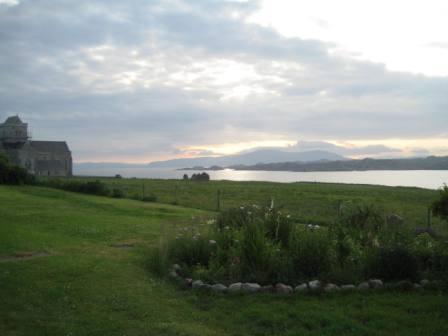
I almost walked by one of the sweetest moments of my recent trip to Iona. In fact, the first time I saw the sign for Iona Pebbles, I did keep walking. That day, I was returning to the hotel from a visit to the rock covered beach at St. Columba’s Bay. I wondered why on earth anyone would want to buy pebbles when they were free and so abundant only steps away.
A few days later, I had a free afternoon. I grabbed a sandwich at the Spar (our equivalent of a 7-Eleven) and headed down the beach on the west side of the island. Along the road, I stopped to talk to Alison, another member of our pilgrimage group. She had just visited Iona Pebbles, where she had met the shop owner and bought some gifts to take home. At Alison’s recommendation, I stopped to meet the “Pebble Lady.”
From the outside, Iona Pebbles looks like the garage of a suburban house. I felt like I was breaking and entering when I opened the door to the empty shop. I was surprised to find tables filled with beautiful jewelry made from polished beach stones. On the walls hung framed photographs of scenes from Iona. I was looking at lavender scented sachets when I heard a woman’s voice coming from out behind the house.
I turned as the woman walked into the shop by the back door. I saw that she was having a conversation with a sheep dog that lie hidden behind the counter. When the woman looked up, she was startled to see me. “Oh, I didn’t know anyone was here,” she said. “Just went to get myself a cup of tea.”
We introduced ourselves, me as a pilgrim from America and she as Val, the artist and shop owner. I selected a half dozen sachets as gifts. As she was packing them for me, Val told me the story of how she began making the sachets.
Val’s mother had been an accomplished seamstress. When dementia made it difficult for her mother to do fine sewing, Val got an idea to keep her mother busy and to use her talents. Val cut out small squares of neutral colored cotton and stamped each piece of cloth with either a saying or an image. She took wool shorn from their flock of sheep, washed it and soaked it with a scented oil. Val matched up two squares – an image on one and a saying on the other - and sewed them together on three sides. She and her mother stuffed the squares with scented wool. Her mother then hand stitched the fourth side to complete the sachet.
“The first couple of batches we made to give away as Christmas gifts,” Val said. “After Mom died, my friends encouraged me to keep making the sachets and to sell them in the shop. They told me there was nothing else like them on the island.”
She was right about that. Each sachet is stamped with more than quotes and an assortment of doves, cats, roses and praying hands. They each hold Val’s sweetness and caring touch. At Iona Pebbles, I found the perfect sentiment – and easy-to-pack gifts – for many of my friends. And, in that short visit with the Pebble Lady, I was reminded that the greatest gifts are made from generosity of spirit, compassion and playfulness.

.JPG)










